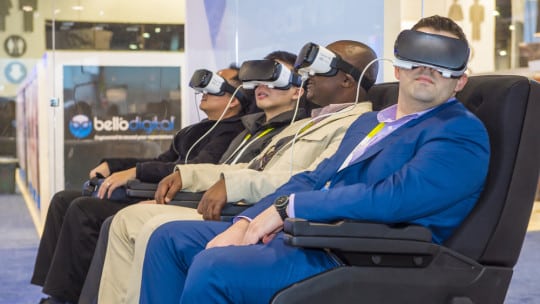
There’s nothing better than a business trip during the first week of January to shock staffers back into the harsh reality of the work world after well-deserved time off during the holidays. While that’s probably not why the Consumer Electronics Show (CES) began Jan. 9—the cost of convention space is lower in early January, particularly in colder climates, and travel budgets are full at the year’s start—it accomplishes the mission well. And when thinking about trends to watch for, as nearly 200,000 people, including 3,800 exhibitors, converge on Las Vegas for CES 2017, what a neat transition to move from the harsh reality of work mentioned above to our first trend:
1. Virtual Reality (VR): When PR News asked veteran CES attendees to spot trends ahead of last year’s CES, nearly all mentioned VR. The proof was in the flooring, literally. CES 2016 boasted an 80% increase in floor space devoted to VR exhibits, notes Michael Bassik, managing director, president, global digital operations MDC Partners Inc. Incidentally, the CES floor is expected to cover some 2.5-million square feet this year. While VR didn’t quite trickle down to the masses as hoped in 2016, it’s clearly coming. And for communicators this means it’s prudent to begin planning for multi-sensory storytelling and creating more exciting, personalized and, frankly, fun experiences for consumers. We’ve already seen this with brands such as Marriott and HBO’s work with hit series Game of Thrones.
2. Augmented Reality (AR): In the media days of CES—the show opens to the public Thursday—VR’s cousin, augmented reality (AR), has poked through. Osterhout Design Group (ODG) introduced a pair of smart glasses whose main feature is its ability to deliver an AR experience, where users see digital images superimposed over the real world, CNET says. The glasses, which cost about $2,000, also can be used to run virtual reality, where the user travels to a totally digital world. Run on the type of chip that powers a high-end smart phone, the glasses are like computers in that users can deploy them to take photos, stream live video and check email. Microsoft, which already has AR glasses known as HoloLens, also has a plan to add to its AR product with technology that helps users track their possessions, such as wallets, mobile phones and car keys. Not only that, the Microsoft AR technology promises to remind you that the milk carton in your fridge is nearly empty. This blends with another related trend, which is the infusion of artificial intelligence (AI) into our quotidian existence. The implications of that for communicators, as well as making use of AR—influencer content about what milk is most healthy, perhaps—seem limitless.
3. Cars Driverless and Connected: Since much of Tuesday and today were dominated by auto companies, “car” was the top-trending word in CES-related social media posts at 2:08 pm ET today. That means a lot of social media, er, traffic was devoted to driverless cars and connected cars. Cars. While electric cars and driverless cars may take many of the headlines at CES this year, don’t discount the massive amount of technology being loaded into cars. “The car is now the biggest connected device we own,” Tim Bajarin, president of market researcher Creative Strategies, tells USA Today.
Again, the implications for communicators are many. First, as the car becomes more connected, it becomes a platform to deliver a message. More than that, a connected car could add to the data being collected about its owner—the routes he or she takes, the venues they visit. Communicators will want to own that data. Moreover, communicators will be called upon to explain to consumers the interest that various brands have in that data. And what about driverless cars, the topic du jour in many tech circles? They might present the best potential for communicators. “Typically technologies pose so many hard questions that they create a very interesting communications playing field,” Brad Williams, chair, global technology practice, Weber Shandwick, told us last year. For example, driverless cars pose not only technology questions but also regulatory ones. “When there are a lot of questions and ambiguity...communications has an important role to play in terms of messaging and public opinion...there are also reputational opportunities and risks.”
4. Data Collection Abounds: This is an overarching trend that touches on the three mentioned above and those not discussed here, such as voice recognition, mobility, robotics and wearables. In some sense, the profusion of data and data collection, which many communicators are well aware of already, are byproducts of everything discussed above. When a device is connected, it’s de facto collecting data, whether you’re wearing it, watching it, driving in it or talking into or to it. How these data are interpreted has become critical to communications. As Brandi Boatner, digital experience manager at IBM, says, “Data: learn it, live it, love it. And do it quickly.”
Follow Seth: @skarenstein
